volume 6 1936-1937
| série: | Tarzan Sunday Pages |
| dessinateur / scénariste: | Foster+Hogarth |
| éditeur: | Flying Buttress EO 1994 |
| genre: | Aventure |
| classement: | biblio1 |
| date: | 1993 |
| format: | cartonné avec jaquette |
| état: | TBE |
| valeur: | 30 € |
| critère: | ** |
| remarques: | sixth volume edited by NBM/Flying Buttress (NBM being America's first publisher of graphic novels since 1976, located at New York with imprints such as Flying Buttress Classics Library, Amerotica, Eurotica and ComicsLit) under the supervision of Bill Blackbeard out of a sery of 18 volumes, all being accurate reproduction of the Sunday Pages in their full colour and in full size, each volume has about 52 pages, n.b. the sources of these Sunday pages are mainly from the Los Angeles Times and from the Milwaukee Journal edited by UFS (United Features Syndicate) volume 6 1936-1937 with dust jacket from 20.9.1936 (289) to 2.5.1937 (321) = 33 pages drawn by Hal Foster, (the page 2-5-1937 being the last page drawn by Foster) 9.5.1937 (322) to 12.9.1937 (340) = 19 pages drawn by Hogarth total 52 pages based on the novel of Edgar Rice Burroughs Tarzan fights the evil empire Flint is building by exploiting natives to work in a rich gold mine, this volume sees the torch gloriously pass from Hal Foster's hands to the no less able ones of Burne Hogarth, with an introduction by James Van Hise who had the chance to interview Hal Foster, the volume includes following episodes (number of pages): - Tarzan in the City of Gold part two: 52 pages drawn by Foster and Hogarth 1/ introduction by James Van Hise "a visit with Hal Foster" - Van Hise mentions Russ Manning' article (1963) stating that the Tarzan of Foster is better than the one of Hogarth because much closer to the idea of the ape-man of Burroughs - according to Foster, the most graphic form of communication and actuality is the story told in pictures (cartoons) in which one can also follow the changing times "however no matter now pretty the picture is, if there is no story or meaning in it, there will be no interest" Foster dixit - a trademark of Foster's comic strip art was his approach of putting the text beneath the art and avoiding the traditional use of word in balloons - during the visite (1971) Foster was then 78 years old and enjoyed his retirement in his new home in Tampa/Florida - Foster was recommended by Joseph Neebe, the man who wanted to adapt books and plays into comic strip form - Foster enjoyed reading historical novels and after 6 years of drawing the ape-man, he agreed to let Hogarth continue the story although he was a fervent admirer of Alex Raymond >> illustration of page 10-2-46 with Prince Valiant in colour (in the days of king Arthur) >> see enclosure - Hogarth took Tarzan over on 9.5.1937 and it was a flawless transition n.b. the story of how Foster decided to make his last weeks on Tarzan so good that the syndicate would find it impossible to replace him with as good an artist but Hogarth proves to be good, even very good 2/ the story Tarzan is planning to overthrow the tyranny of Flint and Gorrey in Taanor, but he is captured and sent to the gold mines with his friends, he rebels again, Flint orders to entomb them in the mine, but Tarzan and his fellow prisoners manage to get out Tarzan organizes now a guerilla warfare against Flint (he is the main enemy now of Tarzan, Gorrey is carried on second plan) >> p. 290 during an sudden attack, why did Tarzan not shoot Flint directly? (he could have done it) but it would have been the end of the story Flint sends an airforce to submit the rebels but Tarzan succeeds in seizing an aeroplane and counter-attacks, Tarzan become the eagle of the skies >> p. 304-308 the air battle (death from the skies) finally Tarzan achieves in forming a strong army and to invest the city of gold. Flint, tyran and coward, uses old king Dalkon to threaten Tarzan but despite this last attempt, Flint and Gorrey are defeated >> p. 316 Tarzan's biggest mistake: he allows Flint and Gorrey to go away unharmed princess Nakonia becomes queen of the golden realm while Flint hires now a modern army to recapture the city of gold, tanks and airplanes attack the city >> 29.7.37 as chief of the Taanor army, Tarzan wears now a long sword >> p. 318 4-11-37 powerful engines of modern warfare against Tarzan's primitive forces first Tarzan succeeds in destroying the airplanes with nets of rope trailed by air balloons but against the mechanized column, he must find some other means >> p. 320/321 similarity with the Italian invasion by Mussolini of the Ethiopian nation (1935-1936) for this purpose, Tarzan seeks alliance with the great gorillas of Bohgdu, with the lion-friends of Lathor and last but not least with the elephants of Tantor; now with all his warriors, his beasts together with the elemental forces of the jungle such as the big rains with mud hindering the progress of the machines, Tarzan is confident to defeat the enemy (the "civilized" foes) >> p. 332 Tarzan and the gorillas n.b. the apes of Foster are better drawn than those of Hogarth (see volume 5 26-1-36 and volume 6 13-6-37) but Tarzan is better drawn by Hogarth >> p. 337 Tarzan and the lions >> p. 339 Tarzan and the elephants = Tarzan's army of soldiers and animal-soldiers = the jungle's army >> p. 336 Tarzan and the small lions (Hogarth's false perspective?) >> p. 337 Tarzan is now king of the kings of beasts >> the story develops a good action with an interesting topic as this second long-featured episode goes on, the art is quite good and the transition between Foster and Hogarth is practically realized without a major difference although the style of Hogarth will become more dynamic with best exemple shown on page 329 last case, whereas case in page 336 is still to improve >> p. 322 to 324 the influence of Foster is still pronounced but on the following pages the own style of Hogarth begins to develop n.b. this album is entirely devoted to the story of the city of gold (the edition Hachette in France with text below the illustrations has reproduced this story in 2 albums: Tarzan and the lion 1937 and Tarzan and the elephants 1938 but these two albums leave out many strips, especially the one of the air battle) Enclosures - front and back cover of the album - last page of Hal Foster (2.5.1937) - first page of Hogarth (9.5.1937) - the blood of Tarzan (Hogarth) - Prince Valiant's page 10.2.46 in colour |
| couvertures: | 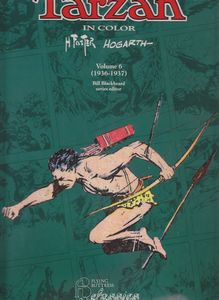 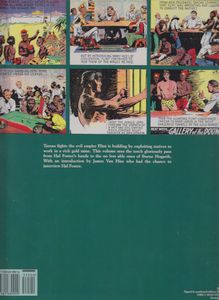 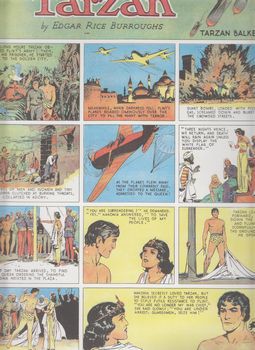 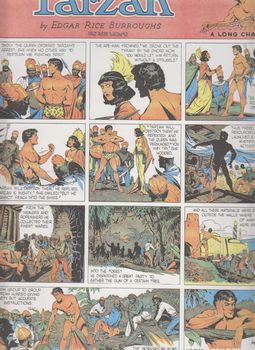 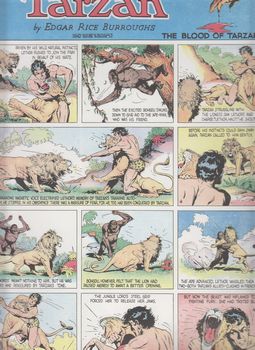 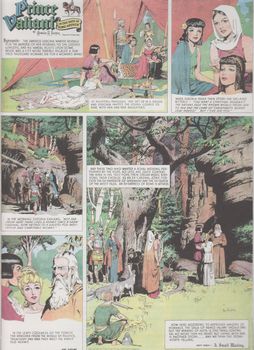 |
Copyright 2008 - 2025 G. Rudolf
